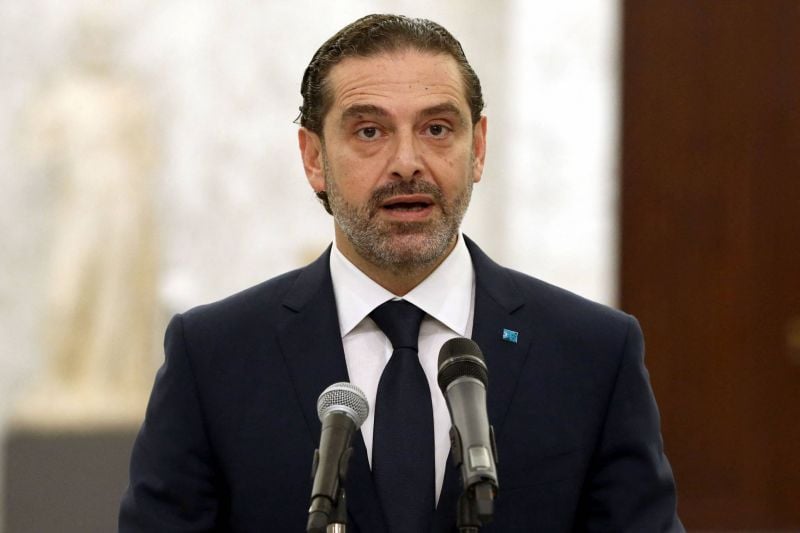
Prime Minister-designate Saad Hariri addresses reporters and TV crews after his meeting with President Michel Aoun on Monday afternoon. (Credit: Dalati & Nohra)
BEIRUT — Prime Minister-designate Saad Hariri made public his cabinet lineup proposal Thursday, as talks between him and President Michel Aoun hit rock bottom after more than seven months of deadlock.
Aoun and Hariri held their 18th meeting in Baabda since the latter was designated to form a government five months ago, with a visibly frustrated Hariri addressing the country less than 30 minutes after talks kicked off.
“I have attempted to facilitate [the formation of the government] but President Aoun is still insisting on a blocking third,” Hariri said.
He said that Aoun is seeking such veto power whether the government has 18, 20 or 22 ministers. Since being designated by 65 MPs in October, Hariri has been pushing to form an 18-member government made up of “independent experts” capable of lifting Lebanon out of the worst economic and financial crisis since the 1975-90 Civil War.
As he made his way out, Hariri handed the lineup, which he said has been ready for over a hundred days, to journalists gathered at the Presidential Palace.
The lineup includes 18 names split along sectarian lines, in line with Lebanon’s power-sharing system:
• Saad Hariri, Prime Minister — Sunni
• Firass Abiad, Health Minister — Sunni
• Nasser Yassine, Social Affairs Minister and Environment Minister — Sunni
• Loubna Meskaoui, Justice Minister — Sunni
• Youssef Khalil, Finance Minister — Shiite
• Maya Kanaan, Labor Minister — Shiite
• Ibrahim Chahrouh, Public Works Minister — Shiite
• Jihad Mortada, Tourism Minister and Minister of State for Administrative Development — Shiite
• Rabih Narch, Foreign Minister and Agriculture Minister — Druze
• Antoine Klimos, Defense Minister — Maronite
• Fadia Kiwan, Culture Minister — Maronite
• Abdo Gerges, Education Minister — Maronite
• Walid Nassar, Information Minister and Youth and Sports Minister — Maronite
• Saadeh El Chami, Economy Minister — Orthodox
• Joe Saddi, Energy Minister — Orthodox
• Ziad Abou Haidar, Interior Minister — Orthodox
• Fadi Samaha, Telecommunications Minister — Catholic
• Garabet Salkhanian, Minister of Industry and Minister for the Displaced — Armenian
Hariri said that Aoun sent him his own incomplete lineup on Sunday, which includes veto power “for him and his group,” asking Hariri to “fill in the blanks.”
“It’s not my job to fill out anyone’s papers,” Hariri said, reiterating that both men should work and agree on the cabinet lineup together as stated by the constitution.
In response, Aoun’s press office made a statement criticizing Hariri, saying the document sent to him laid out the “methodology for forming a government that included four columns.”
The first column is for the size of the government, whether 18 or 20 ministers. The second focuses on the distribution of ministries among the sects. The third column is for the party that proposed the minister. The fourth column is for the names agreed upon based on sect and party backing.
The lineup presented Monday by Hariri was first put forth on Dec. 9, 2020, Aoun’s office said, despite being rejected by the president, adding that accusations of demands for a blocking third were false.
“Hariri is familiar with this methodology, having previously formed two governments on this basis during President Aoun’s time in office,” the president’s office said. On the document released by Aoun’s office, none of the columns were filled out.
An hour later, Hariri came out with his own reply, sharing on Twitter the document he said he received from the president, which shows that the column reserved for party backing had been filled in by Aoun.
In an 18-member government, the list includes six ministers to be appointed by the president to go alongside another from the Armenian Tashnag party, long-standing allies of Aoun’s Free Patriotic Movement. This would constitute a blocking third, or veto power, for the president.
In a 20-member government, the two extra ministers would add to Aoun’s share, with one minister chosen by the president and the other by his Druze ally MP Talal Arslan.
The back and forth took another turn, however, with the president’s office putting out another response moments later, saying the list shared by Hariri dates back to when the two were exchanging “government formulas” and not the list sent to him Sunday.
With Lebanon’s collapse accelerating, French Foreign Minister Jean-Yves Le Drian noted Sunday that Europe must take action, with France to “discuss the Lebanon question” with European counterparts.
“The country is drifting away, divided ... when a country collapses, Europe must be ready,” Le Drian said as he arrived at the EU foreign ministers’ meeting on Monday.
The local currency’s value, which momentarily rose against the dollar over the weekend, began slipping once again as already slim hopes of the government formation dissipated.
The Lebanese lira, pegged at LL1,507 to the dollar since 1997, was trading at over LL14,000 following the meeting, weakening from around LL11,500 earlier in the day.
Update: This article has been amended to include the back-and-forth between the offices of the president and premier-designate following Hariri’s original statement.